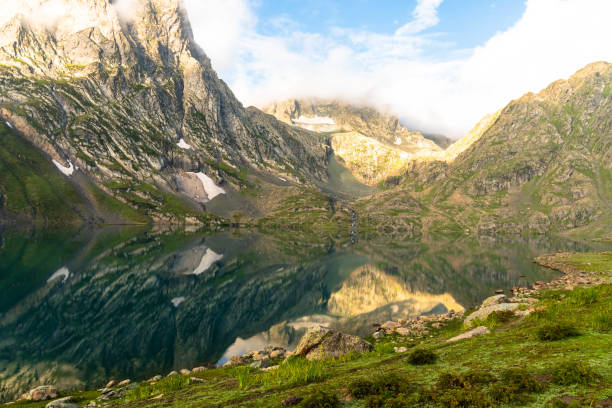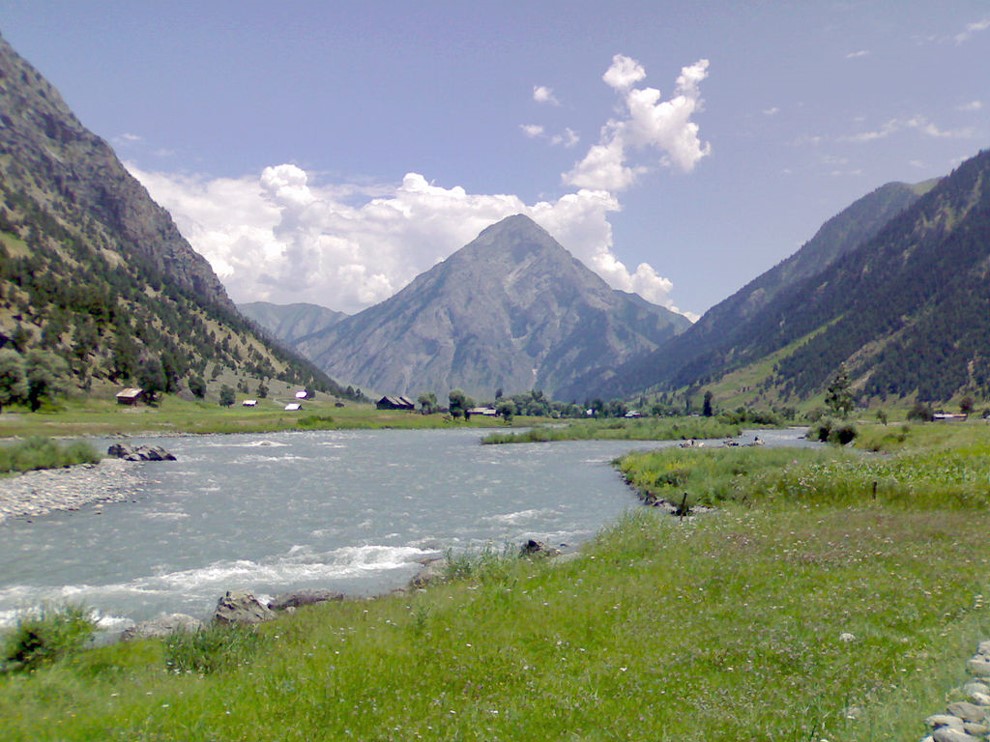Top 5 Beautiful Tourist Destinations in Jammu and Kashmir, India: Exploring Scenic Beauty and Cultural Heritage
Jammu and Kashmir, located in the northernmost region of India, is a land of extraordinary beauty, boasting majestic mountains, pristine lakes, serene meadows, and rich cultural heritage. Among the many stunning destinations in the region, Gulmarg, Pahalgam, Srinagar with Dal Lake, Sonamarg, and Gurez Valley stand out as the most popular and picturesque tourist spots. These places are known for their scenic beauty, historical significance, and unique experiences, making them must-visit destinations for any traveler seeking to explore the best of Jammu and Kashmir.
1. Gulmarg: The Meadow of Flowers
Location and Distance from Srinagar: Gulmarg is located in the Pir Panjal range of the Himalayas, approximately 51 kilometers (31 miles) from Srinagar, the summer capital of Jammu and Kashmir. It is easily accessible via road and is a popular weekend getaway for tourists from Srinagar.

Climate: Gulmarg experiences a temperate climate with cold winters and mild summers. The winter months (from November to February) see heavy snowfall, which makes it a popular destination for winter sports. The temperature during this period can drop to sub-zero levels. Summers (from March to June) are pleasant with temperatures ranging from 15°C to 25°C, making it ideal for sightseeing and outdoor activities.
Famous For: Gulmarg is widely known as the "Meadow of Flowers" due to its lush green meadows that are covered in a blanket of colorful wildflowers, especially during the spring and summer months. The region is a world-renowned skiing destination, with Gulmarg's slopes attracting skiing enthusiasts from all over the globe. It also boasts the Gulmarg Gondola, one of the highest cable cars in the world, which takes visitors to the Apharwat Peak for breathtaking panoramic views of the surrounding mountains and valleys.
The Maharani Temple and St. Mary's Church are also notable historical landmarks that add to the town’s cultural appeal.
For Tourists: Gulmarg offers an array of activities for tourists. In winter, skiing, snowboarding, and snowshoeing are the main attractions. For summer tourists, trekking, golfing, and horse riding are popular activities. The Gulmarg Gondola ride is a highlight for those wishing to take in the spectacular views of the region. In addition to these, Gulmarg also offers opportunities for birdwatching, nature walks, and photography. The meadows are ideal for picnics, and the surrounding forests provide a tranquil environment for relaxation.
2. Pahalgam: The Valley of Shepherds
Location and Distance from Srinagar: Pahalgam is located about 95 kilometers (59 miles) southeast of Srinagar, nestled at the confluence of the Lidder and Aru rivers in the Anantnag district. It is easily accessible by road from Srinagar, and the drive takes approximately 2 to 3 hours.

Climate: Pahalgam experiences a temperate climate, with cold winters and mild summers. Winter temperatures can drop below freezing, while summers are pleasant, with temperatures ranging from 10°C to 20°C. Pahalgam is famous for its beautiful spring and summer seasons, during which the meadows come alive with vibrant wildflowers, and the weather is perfect for outdoor activities.
Famous For: Pahalgam is best known as the base camp for the Amarnath Yatra, one of the most revered Hindu pilgrimages in India. The town attracts thousands of pilgrims every year, who stop here before embarking on the challenging trek to the Amarnath Cave. Pahalgam is also renowned for its Betaab Valley, which was named after the Bollywood film “Betaab” shot here. The valley is known for its lush green meadows and pristine beauty.
Additionally, Pahalgam is a hub for outdoor activities like trekking, trout fishing, horse riding, and golfing. The town’s tranquil setting and beautiful landscapes make it a perfect destination for nature lovers.
For Tourists: Tourists visiting Pahalgam can enjoy activities like trekking to nearby valleys such as Aru Valley, which is known for its scenic beauty and trekking routes. The Baisaran Valley, also known as “Mini Switzerland,” is a must-see with its spectacular views of snow-covered peaks. Horse rides through the scenic landscape of Pahalgam are also a popular tourist activity, as is trout fishing in the Lidder River. Pahalgam’s ancient temples like Mamleshwar Temple and Avantishwar Temple provide a glimpse into the region’s rich history and culture.
3. Srinagar: The City of Lakes
Location and Distance from Gulmarg: Srinagar is situated around 51 kilometers (31 miles) from Gulmarg and is easily accessible by road. It serves as the capital of Jammu and Kashmir and is the hub of tourism in the region.

Climate: Srinagar experiences a continental climate with hot summers and cold winters. Summer temperatures range between 20°C and 35°C, while winter temperatures can fall below freezing, especially in the months of December and January. Snowfall is common during winter, especially in the higher reaches of the city, adding to its charm.
Famous For: Srinagar is famous for its enchanting Dal Lake, which is often referred to as the “Jewel in the Crown of Kashmir.” Dal Lake is known for its floating houseboats, shikaras (wooden boats), and beautiful floating gardens. Visitors can enjoy a tranquil ride on the lake while admiring the beautiful Mughal-style gardens and traditional Kashmiri architecture surrounding the lake.
The city is also known for its Mughal gardens, such as Shalimar Bagh, Nishat Bagh, and Chashme Shahi, which were designed by Mughal emperors and are renowned for their stunning beauty and symmetrical designs.
For Tourists: Srinagar offers an abundance of activities for tourists. A shikara ride on Dal Lake is a must, where tourists can enjoy the calm waters while taking in the beauty of floating gardens, traditional houseboats, and the backdrop of snow-capped mountains. The Mughal gardens are ideal for leisurely walks amidst fountains, terraces, and lush greenery. The ancient Shankaracharya Temple offers panoramic views of the city and Dal Lake, while the Hazratbal Shrine is an important religious site. Shopping for Kashmiri handicrafts, including Pashmina shawls, carpets, and papier-mâché items, is a popular activity in Srinagar's bustling markets like Lal Chowk.
For those looking for adventure, trekking and mountain biking around the surrounding hills are great options, while trout fishing on the nearby rivers is also a popular pastime.
4. Sonamarg: The Meadow of Gold
Location and Distance from Srinagar: Sonamarg is located approximately 80 kilometers (50 miles) northeast of Srinagar, in the Ganderbal district. It is easily accessible by road, and the drive takes around 2-3 hours.

Climate: Sonamarg has a cool, temperate climate with cold winters and mild summers. The temperature in winter can drop significantly below freezing, especially at higher altitudes. Summers, however, are pleasant, with temperatures ranging from 10°C to 20°C, making it a great place for outdoor activities and sightseeing.
Famous For: Sonamarg is known for its breathtaking meadows, which are carpeted with wildflowers in the summer months, giving the region a golden appearance. The town is also famous for its proximity to Thajiwas Glacier, which is a popular spot for trekking and nature walks. The Sindh River, which flows through the region, is known for its crystal-clear waters and is a great place for trout fishing.
For Tourists: Sonamarg offers a range of activities for outdoor enthusiasts. Trekking to nearby valleys like the Vishansar Lake and Krishansar Lake is popular, as these lakes are surrounded by snow-capped peaks and lush meadows. A visit to the Thajiwas Glacier is a must, and tourists can enjoy horse rides and nature walks around the town. Camping by the Sindh River and enjoying the tranquil atmosphere of Sonamarg is a wonderful way to experience the beauty of the region.
5. Gurez Valley: The Hidden Paradise
Location and Distance from Srinagar: Gurez Valley is located approximately 120 kilometers (75 miles) from Srinagar, in the northeastern part of Jammu and Kashmir, near the border with Pakistan. The valley is relatively remote and can be accessed by road through Bandipora.

Climate: Gurez Valley experiences a cold, alpine climate with long, harsh winters and mild summers. Winter temperatures can dip below freezing, while summer temperatures are pleasant, ranging from 15°C to 20°C. The valley is known for its snow-capped peaks and pristine rivers, making it a great destination for nature lovers.
Famous For: Gurez Valley is known for its untouched beauty and is often referred to as a "hidden paradise." The valley is home to the Kishanganga River and offers stunning views of snow-covered mountains and alpine meadows. The region is also famous for its cultural heritage, with the Gujjar and Bakerwal tribes calling it home. Gurez Valley also has historical significance, with several ancient fortresses and shrines scattered across the region.
For Tourists:
Visitors to Gurez can explore the Kishanganga River, which is ideal for fishing and nature walks. The valley is also perfect for trekking, with trails leading to the higher reaches of the region, including the Habba Khatoon Peak. Tourists can also experience the traditional culture of the local Gujjar and Bakerwal tribes by visiting their villages and homes.
Conclusion
Jammu and Kashmir is a land of unparalleled natural beauty, with Gulmarg, Pahalgam, Srinagar, Sonamarg, and Gurez Valley offering some of the most spectacular sights and experiences in India. Whether you are seeking adventure in the snowy slopes of Gulmarg, serenity on the tranquil waters of Dal Lake, a cultural journey in Srinagar, or a peaceful retreat in Sonamarg and Gurez Valley, these destinations provide a diverse range of experiences for every type of traveler. Each place is unique in its own right, making Jammu and Kashmir one of the most sought-after tourist destinations in the world.
Photo Credit to: Pixabay, Unsplash , iStock, utsav.gov.in

